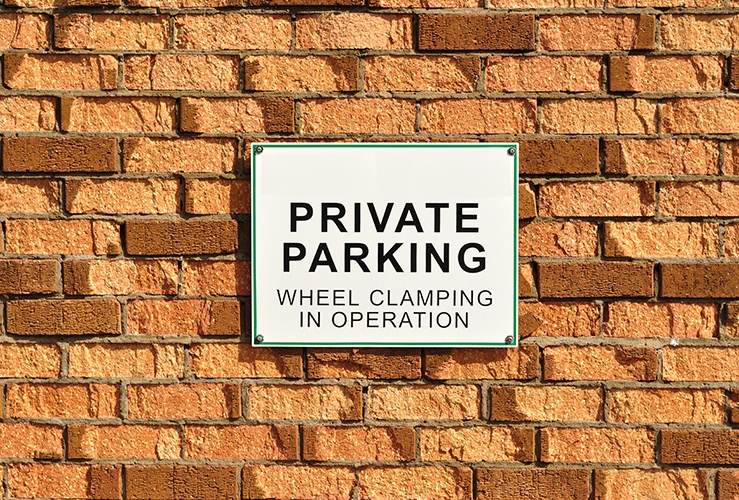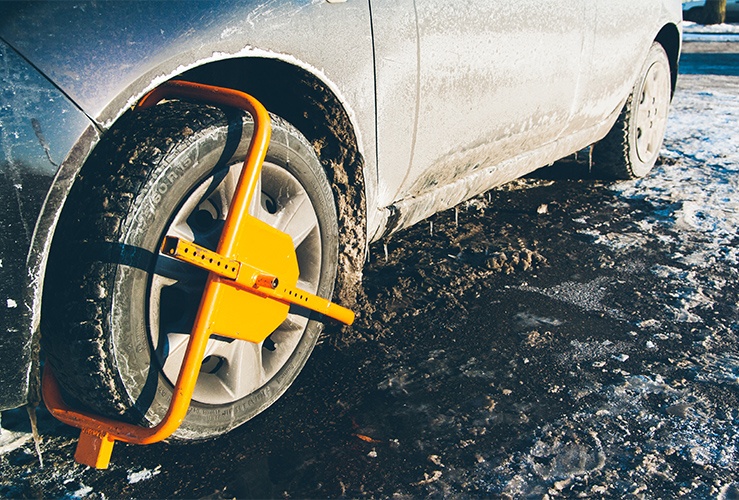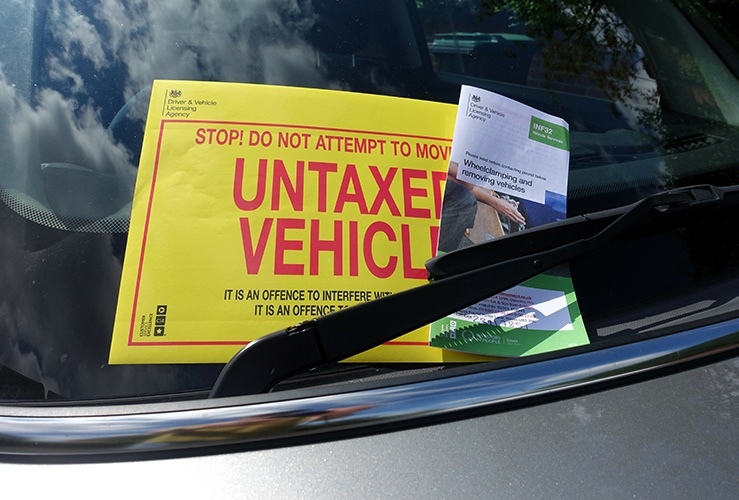If your vehicle has been clamped, you need to act fast to avoid extra fees. Learn about clamping laws, common reasons for clamping, and the clampdown on private clamping, with our complete guide.
Finding a bright yellow clamp on your car is an unpleasant experience. In the short term, it means you can't drive your vehicle and carry on with your day. It also means you'll need to contact the organisation that authorised/installed the clamp, pay any fines, fees or deposits, and wait for the applicable agents to return so it can be removed.
Even more problems will arise if your vehicle has been clamped and then impounded.
In short, a wheel clamp will take your time, give you hassle, and cost you money.
However, in many cases, drivers who find their vehicle has been clamped won’t be entirely surprised – because vehicles are normally only clamped for specific reasons.
Who can authorise a wheel clamp to be fitted on my car?
From a legal standpoint, only police, the DVLA, DVSA, local authorities and a handful of other authorised entities can install a wheel clamp on a vehicle, and (in most cases) only if it’s on public land – such as a publicly accessible road or other restricted area.
Common reasons for getting a vehicle clamped
Under the Road Traffic Regulation Act 1984, vehicles can only be clamped by authorised bodies for certain reasons. These include:
- Vehicle has no road tax (Vehicle Excise Duty)
- Vehicle is parked in a no-waiting area
- Vehicle parked in a restricted area
- Vehicle is on a public road with Statutory Off Road Notification (SORN)
- Vehicle is on private land but doesn’t have SORN
- Vehicle is considered unsafe or a danger to other road users
Clamping laws: public vs private land
While the police, DVLA, and local authorities can clamp vehicles on public land, they cannot, in the vast majority of cases, do the same to vehicles on private land.
However, owners of private land are not legally allowed to clamp a vehicle parked on their land (but they may report the vehicle to the authorities, who may subsequently clamp the vehicle in certain situations) .
Why was clamping on private land banned?
Clamping vehicles on private land was once fairly common. However, because rogue clamping firms would charge excessive release fees, there was a clampdown on this practice via the Protection of Freedoms Act 2012 (PFA 2012), and it was banned.
But the ban didn’t just include clamping: it outlawed any action that stopped a person from moving their vehicle, whether by blocking, towing, or immobilising the vehicle in any other way.
What if I’m blocked from leaving a car park by a fixed barrier?
If you find yourself unable to leave a car park due to a fixed barrier, note that this is not an offence and does not fall under the Protection of Freedoms Act 2012. A person/entity must intend to prevent you from moving your vehicle for it to be an offence.
What about 'clamping in operation' signs on private land?
You may well see ‘clamping in operation’ signs on private land – but these are effectively just for show; no private landowner can clamp, tow or prevent you from moving your vehicle.
However, a private land owner can contact the relevant authorities, who may decide to clamp a vehicle in certain circumstances (e.g. it poses a danger).
What about supermarkets and retail parks?
Places like supermarkets and retail car parks are not public land, so they are not legally permitted to clamp your vehicle. However, car parks operated by local authorities may have wheel clamping in operation since it is classified as public land.
Is it possible to get clamped on private land?
Yes, you can still have your car clamped on private land, but it can only be done by specific bodies, namely the police, DVLA, or local authority. But this would only happen if your vehicle is parked illegally, obstructively, dangerously, or is broken down.
The powers of authorised bodies to carry out clamping on private land were conferred through Section 55 of PFA 2012.
Can any other body carry out wheel clamping?
It’s possible for a range of other private organisations to establish lawful authority to carry out wheel clamping, but these entities operate essential ‘public’ infrastructure, such as:
- Railways/train operators
- Airports
- Harbours
- Strategic river crossing operators
- Owners/managers of common land
My vehicle has been clamped illegally, what do I do?
First of all, any person or organisation found to have clamped your vehicle illegally could be liable to prosecution in either a Crown or Magistrates' court. Crown courts can levy unlimited fines for this offence, while magistrates can impose a fine of up to £5,000.
Whether or not your vehicle has been clamped illegally, your best course of action is to contact the number provided on the clamp or on the notice attached to your windscreen (if there is one).
You should contact the police if you believe your vehicle has been clamped illegally.
What if I arrive while my vehicle is being clamped?
If you arrive to find your vehicle is in the process of being clamped, and the agents then complete the clamping, this may be considered ‘unfair’ and you may be able to dispute it later.
If you find yourself in this situation, it’s a good idea to take photos/videos of the event. You can then use this as evidence during any dispute process.
In most situations, the clamping will be authorised/carried out by the local authority.
Note that if a penalty notice (a parking ticket) has been issued, this will still need to be paid, regardless of whether or not your vehicle has been unfairly clamped.
What happens if I try to remove the clamp myself?
You could be prosecuted for criminal damage if you attempt to remove a legally-installed wheel clamp yourself. And if you keep the wheel clamp, you could be tried for theft, too.
How long before a clamped car is impounded?
Untaxed vehicles "can be clamped or instantly impounded if untaxed," according to the gov.uk website. In other situations, it can be impounded any time after 24 hours.
How do I get a DVLA clamp removed?
The DVLA may clamp any vehicle that is not taxed – i.e., its Vehicle Excise Duty has expired (or was never paid in the first place). An ‘INF32’ leaflet will have been left on the vehicle: call the number printed on this (this will normally be an NSL contact number, see below).
You will then either have to pay the outstanding VED or something called a 'surety fee' – which is basically a deposit.
How much is the DVLA surety fee?
The surety fee is £160 for cars and motorcycles, and up to £700 for other vehicle types.
You will also need to pay the release fee, which is £100 if paid within 24 hours. Fees can increase after 24 hours, so it’s important to act quickly if your car has been clamped by the DVLA (or any other entity).
Note that the DVLA can impound your vehicle after 24 hours and even has the power to destroy it after seven days of unpaid storage.
Who is NSL?
NSL is a private firm that has a long-standing contract with the DVLA (and other entities, including 60 local councils) to provide parking enforcement services.
If your vehicle gets impounded by the DVLA (or other entity), you will need to contact NSL.
NSL
0343 224 1999
As mentioned, you’ll pay less if you get your vehicle released within 24 hours.
DVSA Clamping
The DVSA - Driver and vehicle Standards Agency - can also clamp a vehicle if it is a danger to other road users. In many cases, however, commercial vehicles are the subject of DVSA clamping activities.
A vehicle may be clamped by the DVSA for the following reasons:
- A vehicle is overloaded
- A vehicle is parked dangerously
- A vehicle’s driver has been driving longer than they are legally permitted to
- A driver has unpaid DVSA fines
An INF32 leaflet will have been left on your vehicle. Call the number printed on this, then pay any fees in order to start the release process.







